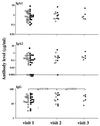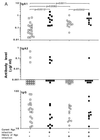Limited local and systemic antibody responses to Neisseria gonorrhoeae during uncomplicated genital infections
- PMID: 10417159
- PMCID: PMC96675
- DOI: 10.1128/IAI.67.8.3937-3946.1999
Limited local and systemic antibody responses to Neisseria gonorrhoeae during uncomplicated genital infections
Abstract
Repeated infections with Neisseria gonorrhoeae are common among patients attending sexually transmitted disease clinics. We examined whether previous infections or site of infection altered the local and systemic antigonococcal antibody levels in males and females. Antibodies against N. gonorrhoeae MS11 and the patients' homologous infecting isolates were measured by enzyme-linked immunosorbent assay. In general, the local and systemic immune responses to gonococci were extremely modest. There was a slight increase in serum immunoglobulin G (IgG) against the MS11 strain and the homologous isolates in infected males. Levels of serum IgA1 antibodies against MS11 were slightly higher in infected than in uninfected females. A history of previous infections with N. gonorrhoeae did not alter the antibody levels in patients with a current infection, suggesting that immunological memory is not induced by uncomplicated gonococcal infections. Antibody responses to infected subjects' homologous isolates were observed in cervical mucus; IgA1 levels increased while IgG levels decreased. The decline in mucosal IgG against the homologous isolates was less common in subjects having both rectal and cervical infections; otherwise, no effect of rectal involvement was observed. The absence of substantially higher antibody levels to gonococci where there is infection at a site known to contain organized lymphoid tissue suggests that the low levels of responses to uncomplicated infections may not be due simply to an absence of inductive sites in the genital tract. We propose that in addition to its potential ability to avoid the effects of an immune response, N. gonorrhoeae does not elicit strong humoral immune responses during uncomplicated genital infections.
Figures






References
-
- Beck E J, Mandalia S, Leonard K, Griffith R J, Harris J R, Miller D L. Case-control study of sexually transmitted diseases as cofactors for HIV-1 transmission. Int J STD AIDS. 1996;7:34–38. - PubMed
-
- Bélec L, Dupré T, Prazuck T, Tévi-Bénissan C, Kanga J-M, Pathey O, Lu X-S, Pillot J. Cervicovaginal overproduction of specific IgG to human immunodeficiency virus (HIV) contrasts with normal or impaired IgA local response in HIV infection. J Infect Dis. 1995;172:691–697. - PubMed
-
- Boslego J W, Tramont E C, Chung R C, McChesney D G, Ciak J, Sadoff J C, Piziak M V, Brown J D, Brinton C C, Jr, Wood S W, Bryan J R. Efficacy trial of a parenteral gonococcal pilus vaccine in men. Vaccine. 1991;9:154–162. - PubMed
-
- Crowley-Nowick P A, Bell M C, Brockwell R, Edwards R P, Chen S, Partridge E E, Mestecky J. Rectal immunization for induction of specific antibody in the genital tract of women. J Clin Immunol. 1997;17:370–379. - PubMed
Publication types
MeSH terms
Substances
Grants and funding
LinkOut - more resources
Full Text Sources
Medical

